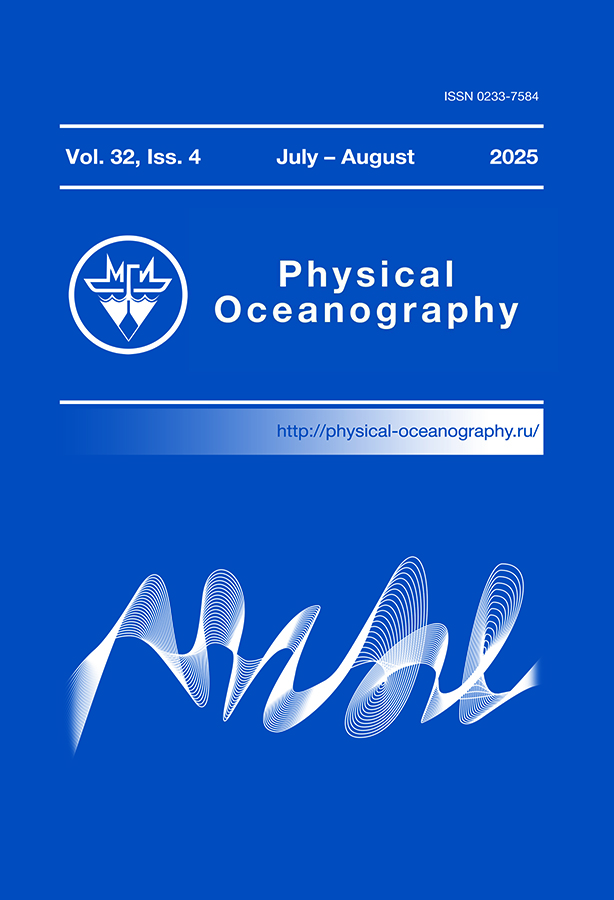Russian Federation
Russian Federation
Purpose. The purpose of the study is to introduce a new method for measuring the spectral absorption of light using suspended and dissolved organic matter directly in seawater, without its prior concentration or filtration onto a substrate. Methods and Results. A new method is proposed for determining light absorption by impurities in seawater. It is based on the application of two reflective double-walled conical cuvettes of large length (connected at the input to an integrating sphere) and assembled according to the optical scheme of a two-beam differential spectrophotometer. The cuvettes are identical thin-walled quartz cones coaxially inserted inside the same outer cones, the latter having a mirror coating. When seawater is placed in the measuring channel and the deionized water is placed in the reference channel for comparison, only the total absorption by suspended matter and colored dissolved organic matter will be defined. It is necessary to pour the filtrate of the same seawater that was passed through the 0.2 µm-pore filter into the reference cuvette to determine only the light absorption by suspended matter in seawater. The seawater filtrate placed in the measuring channel and compared to the optically pure water in the reference channel permits determination of the spectrum of dissolved organic matter absorption in the original seawater. Conclusions. For the first time, the spectral characteristics of light absorption by suspended matter in an aqueous medium are being defined directly in its natural state. This is being achieved by significantly increasing sensitivity, provided that all the scattered rays are collected completely by the receiving device. This is made possible by a method that uses double-walled conical quartz glass cuvettes, which increase the reflection angle by the value of the cone apex with each subsequent reflection. Therefore, the combination of conical cuvettes in the optical scheme of a two-beam differential photometer with an integrating sphere allows to obtain accurate data that require no more corrections for the influence of scattered rays. The principle of a two-beam differential spectrophotometer proposed and applied in the study makes it possible to perform spectral analyses of the absorption characteristics of various suspended matter components separately from all other substances and the properties of the seawater in which they are present.
suspended particles, dissolved organic matter, light absorption, scattering medium, total internal reflection, double-walled cone cuvette, scattering angle
1. Ciotti, A.M., Lewis, M.R. and Cullen, J.J., 2002. Assessment of the Relationships between Dominant Cell Size in Natural Phytoplankton Communities and the Spectral Shape of the Absorption Coefficient. Limnology and Oceanography, 47(2), pp. 404-417. https://doi.org/10.4319/lo.2002.47.2.0404
2. Marra, J., Trees, C.C. and O’Reilly, J.E., 2007. Phytoplankton Pigment Absorption: A Strong Predictor of Primary Productivity in the Surface Ocean. Deep Sea Research Part I: Oceanographic Research Papers, 54(2), pp. 155-163. https://doi.org/10.1016/j.dsr.2006.12.001
3. Torrecilla, E., Stramski, D., Reynolds, R.A., Millán-Núñez, E. and Piera, J., 2011. Cluster Analysis of Hyperspectral Optical Data for Discriminating Phytoplankton Pigment Assemblages in the Open Ocean. Remote Sensing of Environment, 115(10), pp. 2578-2593. https://doi.org/10.1016/j.rse.2011.05.014
4. Mobley, C.D., 1994. Light and Water. Radiative Transfer in Natural Waters. San Diego: Academic Press, 592 p.
5. Behrenfeld, M.J. and Falkowski, P.G., 1997. A Consumer’s Guide to Phytoplankton Primary Productivity Models. Limnology and Oceanography, 42(7), pp. 1479-1491. https://doi.org/10.4319/lo.1997.42.7.1479
6. Karl, D.M., Knauer, G.A. and Martin, J.H., 1988. Downward Flux of Particulate Organic Matter in the Ocean: A Particle Decomposition Paradox. Nature, 332, pp. 438-441. https://doi.org/10.1038/332438a0
7. Blough, N.V. and Del Vecchio, R., 2002. Chromophoric DOM in the Coastal Environment. In: D. A. Hansell and C. A. Carlson, eds., 2002. Biogeochemistry of Marine Dissolved Organic Matter. San Diego: Academic Press, pp. 509-546. https://doi.org/10.1016/B978-012323841-2/50012-9
8. Twardowski, M.S., Boss, E., Sullivan, J.M. and Donaghay, P.L., 2004. Modeling the Spectral Shape of Absorption by Chromophoric Dissolved Organic Matter. Marine Chemistry, 89(1-4), pp. 69-88. https://doi.org/10.1016/j.marchem.2004.02.008
9. Lee, Z.P., Carder, K.L. and Arnone, R.A., 2002. Deriving Inherent Optical Properties from Water Color: A Multiband Quasi-Analytical Algorithm for Optically Deep Waters. Applied Optics, 41(27), pp. 5755-5772. https://doi.org/10.1364/ao.41.005755
10. Woźniak, S.B. and Stramski, D., 2004. Modeling the Optical Properties of Mineral Particles Suspended in Seawater and Their Influence on Ocean Reflectance and Chlorophyll Estimation from Remote Sensing Algorithms. Applied Optics, 43(17), pp. 3489-3503. https://doi.org/10.1364/ao.43.003489
11. Mitchell, B.G., 1990. Algorithms for Determining the Absorption Coefficient for Aquatic Particulates Using the Quantitative Filter Technique. In: R. W. Spinrad, ed., 1990. Proceedings of SPIE: Ocean Optics X. Vol. 1302, pp. 137-148. https://doi.org/10.1117/12.21440
12. Tassan, S. and Ferrari, G.M., 1995. An Alternative Approach to Absorption Measurements of Aquatic Particles Retained on Filters. Limnology and Oceanography, 40(8), pp. 1358-1368. https://doi.org/10.4319/LO.1995.40.8.1358
13. Maske, H. and Haardt, H., 1987. Quantitative in Vivo Absorption Spectra of Phytoplankton: Detrital Absorption and Comparison with Fluorescence Excitation Spectra 1. Limnology and Oceanography, 32(3), pp. 620-633. https://doi.org/10.4319/lo.1987.32.3.0620
14. Röttgers, R. and Gehnke, S., 2012. Measurement of Light Absorption by Aquatic Particles: Improvement of the Quantitative Filter Technique by Use of an Integrating Sphere Approach. Applied Optics, 51(9), pp. 1336-1351. https://doi.org/10.1364/AO.51.001336
15. Kishino, M., Takahashi, M., Okami, N. and Ichimura, S., 1985. Estimation of the Spectral Absorption Coefficients of Phytoplankton in the Sea. ICES Journal of Marine Science, 37(2), pp. 634-642.
16. Ferrari, G.M. and Tassan, S., 1999. A Method Using Chemical Oxidation to Remove Light Absorption by Phytoplankton Pigments. Journal of Phycology, 35(5), pp. 1090-1098. https://doi.org/10.1046/j.1529-8817.1999.3551090.x
17. Röttgers, R., Schönfeld, W., Kipp, P.-R. and Doerffer, R., 2005. Practical Test of a Point-Source Integrating Cavity Absorption Meter: The Performance of Different Collector Assemblies. Applied Optics, 44(26), pp. 5549-5560. https://doi.org/10.1364/AO.44.005549
18. Glukhovets, D.I., Sheberstov, S.V., Kopelevich, O.V., Zaytseva, A.F. and Pogosyan, S.I., 2017. Measuring the Sea Water Absorption Factor Using Integrating Sphere. Light & Engineering, 26(1), pp. 120-126. https://doi.org/10.33383/2016-079
19. Neukermans, G., Reynolds, R.A. and Stramski, D., 2014. Contrasting Inherent Optical Properties and Particle Characteristics between an Under-Ice Phytoplankton Bloom and Open Water in the Chukchi Sea. Deep Sea Research Part II: Topical Studies in Oceanography, 105, pp. 59-73. https://doi.org/10.1016/J.DSR2.2014.03.014
20. Lohrenz, S.E., 2000. A Novel Theoretical Approach to Correct for Pathlength Amplification and Variable Sampling Loading in Measurements of Particulate Spectral Absorption by the Quantitative Filter Technique. Journal of Plankton Research, 22(4), pp. 639-657. https://doi.org/10.1093/plankt/22.4.639
21. Stramski, D., Reynolds, R.A., Kaczmarek, S., Uitz, J. and Zheng, G., 2015. Correction of Pathlength Amplification in the Filter-Pad Technique for Measurements of Particulate Absorption Coefficient in the Visible Spectral Region. Applied Optics, 54(22), pp. 6763-6782. https://doi.org/10.1364/AO.54.006763
22. Hoepffner, N. and Sathyendranath, S., 1993. Determination of the Major Groups of Phytoplankton Pigments from the Absorption Spectra of Total Particulate Matter. Journal of Geophysical Research: Oceans, 98(C12), pp. 22789-22803. https://doi.org/10.1029/93JC01273
23. Neeley, A.R., Freeman, S.A. and Harris, L.A., 2015. Multi-Method Approach to Quantify Uncertainties in the Measurements of Light Absorption by Particles. Optics Express, 23(24), pp. 31043-31058. https://doi.org/10.1364/OE.23.031043
24. Van de Hulst, H.C., 1981. Light Scattering by Small Particles. New York: Dover Publications, 470 p.
25. Lee, M.E. and Shybanov, E.B., 2023. The Concept of a New Approach to the Determination of the Spectral Absorption of Light in Clear Seawater. In: SIO RAS, 2023. Proceedings of the XII All-Russian Conference with International Participation “Current Problems in Optics of Natural Waters”. Moscow: Shirshov Institute Publishing House, pp. 97-102 (in Russian).
26. Mankovsky, V.I., 1971. [On the Relationship between the Integral Indicator of Light Scattering of Sea Waters and the Indicator of Scattering in a Fixed Direction]. Marine Hydrophysical Research, (6), pp. 145-154 (in Russian).
27. Lee, M.E. and Shybanov, E.B., 2024. New Method for Determining Spectral Absorption of Light in the Sea. Physical Oceanography, 31(2), pp. 178-193.
28. Lee, M.E. and Shybanov, E.B., 2024. A New Approach to Determining the Spectral Light Absorption of Seawater by a Conical Reflecting Cuvette with an Integrating Sphere. Fundamental and Applied Hydrophysics, 17(3), pp. 9-20. https://doi.org/10.59887/2073-6673.2024.17(3)-1
29. Petzold, T.J., 1972. Volume Scattering Functions for Selected Ocean Waters. UC San Diego: Scripps Institution of Oceanography, 82 p.
30. Kullenberg, G., 1968. Scattering of Light by Sargasso Sea Water. Deep Sea Research and Oceanographic Abstracts, 15(4), pp. 423-432. https://doi.org/10.1016/0011-7471(68)90050-8
31. Pope, R.M. and Fry, E.S., 1997. Absorption Spectrum (380–700 nm) of Pure Water. II. Integrating Cavity Measurements. Applied Optics, 36(33), pp. 8710-8723. https://doi.org/10.1364/AO.36.008710
32. Smith, R.C. and Baker, K.S., 1981. Optical Properties of the Clearest Natural Waters (200–800 nm). Applied Optics, 20(2), pp. 177-184. https://doi.org/10.1364/AO.20.000177















